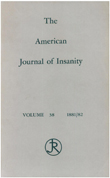Initial reliability and validity of the childhood trauma interview: a new multidimensional measure of childhood interpersonal trauma
Abstract
OBJECTIVE: The Childhood Trauma Interview, a new instrument for brief and comprehensive retrospective assessment of childhood interpersonal trauma, is presented with initial evidence of its reliability and validity. METHOD: Drug- or alcohol-dependent patients (N = 220) were given the Childhood Trauma Interview and a questionnaire measure of child abuse, the Childhood Trauma Questionnaire. Convergent and discriminant validity for the Childhood Trauma Interview were tested by comparing correlations between analogous and nonanalogous trauma scales to those of the Childhood Trauma Questionnaire. RESULTS: Interrater reliability for the majority of trauma dimensions measured by the Childhood Trauma Interview was very high (63% had intraclass correlations above 0.90). Principal-components analysis yielded six rotated factors that accounted for 74% of the variance among scores: separations and losses, physical neglect, emotional abuse or assault, physical abuse or assault, witnessing violence, and sexual abuse or assault. Since these six factors exactly represented the areas that the interview was designed to assess, the construct validity of the Childhood Trauma Interview was supported. Without exception, convergent correlations were significantly higher than discriminant correlations, and convergence was improved when multidimensional variables from the Childhood Trauma Interview and their interactions were regressed onto Childhood Trauma Questionnaire scores. CONCLUSIONS: These initial findings suggest that the Childhood Trauma Interview is a reliable and valid method for brief assessment of multiple dimensions of six types of childhood interpersonal trauma.
Access content
To read the fulltext, please use one of the options below to sign in or purchase access.- Personal login
- Institutional Login
- Sign in via OpenAthens
- Register for access
-
Please login/register if you wish to pair your device and check access availability.
Not a subscriber?
PsychiatryOnline subscription options offer access to the DSM-5 library, books, journals, CME, and patient resources. This all-in-one virtual library provides psychiatrists and mental health professionals with key resources for diagnosis, treatment, research, and professional development.
Need more help? PsychiatryOnline Customer Service may be reached by emailing [email protected] or by calling 800-368-5777 (in the U.S.) or 703-907-7322 (outside the U.S.).



